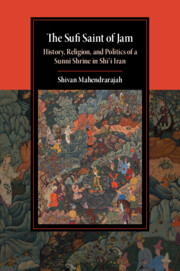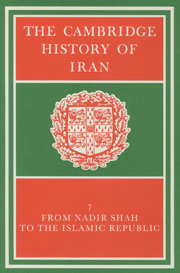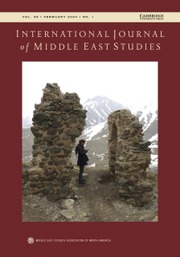The Sufi Saint of Jam
History, Religion, and Politics of a Sunni Shrine in Shi'i Iran
$44.99 USD
Part of Cambridge Studies in Islamic Civilization
- Author: Shivan Mahendrarajah, University of St Andrews, Scotland
- Date Published: May 2021
- availability: This ISBN is for an eBook version which is distributed on our behalf by a third party.
- format: Adobe eBook Reader
- isbn: 9781108881029
Find out more about Cambridge eBooks
$
44.99 USD
Adobe eBook Reader
Other available formats:
Hardback, Paperback
Looking for an inspection copy?
This title is not currently available on inspection
-
The Sunni saint cult and shrine of Ahmad-i Jam has endured for 900 years. The shrine and its Sufi shaykhs secured patronage from Mongols, Kartids, Tamerlane, and Timurids. The cult and shrine-complex started sliding into decline when Iran's shahs took the Shiʿi path in 1501, but are today enjoying a renaissance under the (Shiʿi) Islamic Republic of Iran. The shrine's eclectic architectural ensemble has been renovated with private and public funds, and expertise from Iran's Cultural Heritage Organization. Two seminaries (madrasa) that teach Sunni curricula to males and females were added. Sunni and Shiʿi pilgrims visit to venerate their saint. Jami mystics still practice ʿirfan ('gnosticism'). Analyzed are Ahmad-i Jam's biography and hagiography; marketing to sultans of Ahmad as the 'Guardian of Kings'; history and politics of the shrine's catchment area; acquisition of patronage by shrine and shaykhs; Sufi doctrines and practices of Jami mystics, including its Timurid-era Naqshbandi Sufis.
Read more- Explores how this Iranian Sunni saint community is enjoying a renaissance under the allegedly 'sectarian' and 'intolerant' Shiʿi theocracy
- An interdisciplinary study, appealing to students and scholars of Islamic, Iranian, and Afghan History; Islamic Studies and Sufism, Islamic Art and Architecture
- Scholars of Islamic Art and Architecture will benefit from original schematics of the shrine-complex's components and twenty color plates
Reviews & endorsements
'An innovative contribution to the history of a 900 year-old Sunni shrine in the Islamic Republic of Iran. The longevity of Shaykh al-Islam Ahmad-i Jam's shrine rests on his descendants who venerate his memory and protect his legacy, despite the divisions between Sunnis and Shiites. Today, the shrine is part of Iran's rich cultural heritage and the center of Friday prayers for Turbat-i Jām's Sunnis and for the Hawza-yi 'ilmiyya Ahmadiyya. This fascinating book not only displays an intimate knowledge of textual sources, but is also reflective of the author's experience visiting major shrines in Iran. Highly recommended.' Denise Aigle, École Pratique des Hautes Études, Centre National de la Recherche Scientifique, UMR Orient & Méditerranée, Paris
See more reviews'An exhaustive, thoroughly researched and entirely original study of a little-known but significant Sufi lineage in North Eastern Iran. Mahendrarajah has not only examined all the textual sources detailing its complex history, but also visited the town of Jam, where this Sufi group of Sunni orientation remains active without hindrance. Warmly recommended.' Hamid Algar, University of California, Berkeley
'This rich and enlightening book presents a multi-faceted portrait of a Sufi order, a family, and a shrine over ten centuries, up to the present. Mahendrarajah has mastered social and political history, architectural analysis and doctrinal developments; his work should interest all scholars of Iran and its culture.' Beatrice F. Manz, Tufts University
'This book represents an essential resource for studying the quasi-permanent or slowly evolving functions of Sufi institutions in Khurasan from the Middle Ages to the present. One of the great values of Shivan Mahendrarajah's book is the innovative multi-disciplinary approach he has applied to the subject.' Eszter Luca Csontos, Acta Orientalia
'… a very fine analysis of the hagiographic process in an interlocking of durations reconstituted with great precision.' Stéphane A. Dudoignon, Die Welt des Islams (in French)
'… an important work that urges us to reconsider our understanding of Sufi religious spaces while providing an exciting new model for future studies.' Najam Haider, Journal of the American Oriental Society
'A long and fascinating journey through the history of the institution of Turbat-i Jām.' Alexandre Papas, Journal of Sufi Studies
Customer reviews
Not yet reviewed
Be the first to review
Review was not posted due to profanity
×Product details
- Date Published: May 2021
- format: Adobe eBook Reader
- isbn: 9781108881029
- availability: This ISBN is for an eBook version which is distributed on our behalf by a third party.
Table of Contents
Introduction
Part I. The Saint:
1. Biography and Hagiography
2 Saintdom and Patronage
Part II. The Successors:
3: Ilkhanid/Kartid Eras to the Timurid Age
4: Safavid/Mughal Eras to the Islamic Republic
Part III. The Shrine:
5. Setting, Architecture and Administration
6. Agro- and Hydro-Management
7. Public Service in the Catchment Area
8. Sacred Topography and Islamic Learning
Part IV. The Sufis:
9. Doctrines and Practices
Conclusion.
Sorry, this resource is locked
Please register or sign in to request access. If you are having problems accessing these resources please email [email protected]
Register Sign in» Proceed
You are now leaving the Cambridge University Press website. Your eBook purchase and download will be completed by our partner www.ebooks.com. Please see the permission section of the www.ebooks.com catalogue page for details of the print & copy limits on our eBooks.
Continue ×Are you sure you want to delete your account?
This cannot be undone.
Thank you for your feedback which will help us improve our service.
If you requested a response, we will make sure to get back to you shortly.
×




